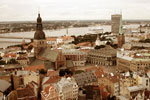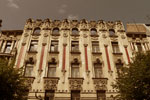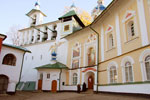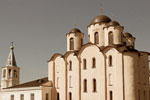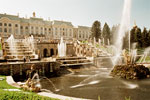Discover Russia through the Baltics
Baltics - the Window to Russia
Riga – Veliky Novgorod - Saint Petersburg – Tartu – Riga
Day 1: Arrival to Riga. Visit to the Old City
Since its foundation in 1201 to the present days, Riga has been the regional centre and the largest city of the Baltic states. Situated on the ancient trade route between East and West, Riga has one of the major sea ports of the Baltic Sea. With the proclamation of Latvian independence in 1918, Riga became the capital of Latvia. In 2014, the city will host the European Capital of Culture. >>> read more
Since its foundation in 1201 to the present days, Riga has been the regional centre and the largest city of the Baltic states. Situated on the ancient trade route between East and West, Riga has one of the major sea ports of the Baltic Sea. With the proclamation of Latvian independence in 1918, Riga became the capital of Latvia. In 2014, the city will host the European Capital of Culture. >>> read more
Day 2: Contrasts of Riga
Apart from the Old City, the most notable landmarks of Riga are the 19th century circle of boulevards and bourgeois residential quarters, showing all the charm of Art Nouveau architecture, which UNESCO believes to be unparalleled anywhere in the world. The prosperity of the 19th century led to the establishment of a new beach and health resort on the southern coast of the Gulf of Riga. Since then, >>> read more
Apart from the Old City, the most notable landmarks of Riga are the 19th century circle of boulevards and bourgeois residential quarters, showing all the charm of Art Nouveau architecture, which UNESCO believes to be unparalleled anywhere in the world. The prosperity of the 19th century led to the establishment of a new beach and health resort on the southern coast of the Gulf of Riga. Since then, >>> read more
Day 3: Through ancient Livonia
The expansion of the Hanseatic League in the 12th century brought a new political and religious order to the lands on the eastern coast of the Baltic Sea. Livonia, the lands of Baltic and Finnic tribes comprising present-day Latvia and Estonia were Christianised and came under the rule of the Holy See. Up until now, Latvia and Estonia represent Europe's eastern boarder with Russia, and is the place where the >>> read more
The expansion of the Hanseatic League in the 12th century brought a new political and religious order to the lands on the eastern coast of the Baltic Sea. Livonia, the lands of Baltic and Finnic tribes comprising present-day Latvia and Estonia were Christianised and came under the rule of the Holy See. Up until now, Latvia and Estonia represent Europe's eastern boarder with Russia, and is the place where the >>> read more
Day 4: Off to Russia: Pechory - "The Monastery in the Caves"
The origins of Russia were shaped by the emerging principalities of East Slavs living in the upper basins of the rivers Dnepr and Volga some three hundred years before the rise of Livonia. Under the influence of Byzantium and following the Christianization of Kievan Rus' in the 10th century, all Russian lands adopted Orthodox Christianity. Both the Russian state and >>> read more
The origins of Russia were shaped by the emerging principalities of East Slavs living in the upper basins of the rivers Dnepr and Volga some three hundred years before the rise of Livonia. Under the influence of Byzantium and following the Christianization of Kievan Rus' in the 10th century, all Russian lands adopted Orthodox Christianity. Both the Russian state and >>> read more
Day 5: Veliky Novgorod - hometown of Russia
Veliky Novgorod is considered to be the starting point on the timeline of Russian history. The Millennium of Russia is a monument that was erected in the Novgorod Kremlin in 1862 to celebrate Russia's thousand-year anniversary. In opposition to the later predominantly autocratic style of rule, Novgorod, along with neighbouring Pskov, were the only Russian city-republics that were governed >>> read more
Veliky Novgorod is considered to be the starting point on the timeline of Russian history. The Millennium of Russia is a monument that was erected in the Novgorod Kremlin in 1862 to celebrate Russia's thousand-year anniversary. In opposition to the later predominantly autocratic style of rule, Novgorod, along with neighbouring Pskov, were the only Russian city-republics that were governed >>> read more
Day 6: The Northern Jewel - Saint Petersburg
Foundation of Saint Petersburg by Tsar Peter the Great in 1703 emerged to be a milestone in Russian history. Peter's project to construct a completely new city on marshland, along with Russia's first naval base on the Baltic Sea, was part of his lifelong undertaking to modernize and Westernize Russia. The city became the new capital of Russian Empire and remained so for two hundred years. >>> read more
Foundation of Saint Petersburg by Tsar Peter the Great in 1703 emerged to be a milestone in Russian history. Peter's project to construct a completely new city on marshland, along with Russia's first naval base on the Baltic Sea, was part of his lifelong undertaking to modernize and Westernize Russia. The city became the new capital of Russian Empire and remained so for two hundred years. >>> read more
Day 7: Bridges and canals of Neva River
Being fond of Dutch culture, Peter the Great's conception of his new city was inspired by Amsterdam. He chose to locate the city centre on Vasilievsky Island and hoped to construct a rectangular grid network of avenues and canals. In Peter's absence, however, the canals had been dug too narrow and, much to Peter's upset, the dream of Russian Amsterdam had to be abandoned. >>> read more
Being fond of Dutch culture, Peter the Great's conception of his new city was inspired by Amsterdam. He chose to locate the city centre on Vasilievsky Island and hoped to construct a rectangular grid network of avenues and canals. In Peter's absence, however, the canals had been dug too narrow and, much to Peter's upset, the dream of Russian Amsterdam had to be abandoned. >>> read more
Day 8: Peterhof, a paradise of fountains and cascades
In and around Saint Petersburg, there is a high density of luxurious palaces and mansions that all tell us of the wealth of the ruling elite of pre-revolutionary Russia. The rapid growth of the poor workers' boroughs started after the Peasant Reform of 1861, with serfs becoming free citizens. The reconstruction and integration of these outskirts started after the revolution in 1920s. >>> read more
In and around Saint Petersburg, there is a high density of luxurious palaces and mansions that all tell us of the wealth of the ruling elite of pre-revolutionary Russia. The rapid growth of the poor workers' boroughs started after the Peasant Reform of 1861, with serfs becoming free citizens. The reconstruction and integration of these outskirts started after the revolution in 1920s. >>> read more
Day 9: University town Tartu
The Estonian city of Tartu is best known for its university. Founded by the Swedes in 1632, the university is the second oldest in the region after Vilnius University. Due to the Russian-Swedish wars, the university was moved and closed several times. During the decades after it was reopened by the Baltic Germans in 1802, the fame of the university grew and reached its peak in 1860s and 70s. >>> read more
The Estonian city of Tartu is best known for its university. Founded by the Swedes in 1632, the university is the second oldest in the region after Vilnius University. Due to the Russian-Swedish wars, the university was moved and closed several times. During the decades after it was reopened by the Baltic Germans in 1802, the fame of the university grew and reached its peak in 1860s and 70s. >>> read more
Day 10: Returning home
Please, do ask for flexible dates
Included:
- Visas for Russia
- 9 Hotel accommodations with breakfast (3* and 4*)
- English/German speaking tour guide
- Museum guides and entrance fees according to the itinerary
- Transfers and coach travel
- Comfortable van for small groups
- Travel documentation
Not included in the price:
- Travel insurance
- Arrival/departure fares
- Unscheduled admission fees
- Personal expenses
- Tips
Required documents:
- A valid travel passport
© 2010 by Baltic Travel Network @ Sacred Miles
